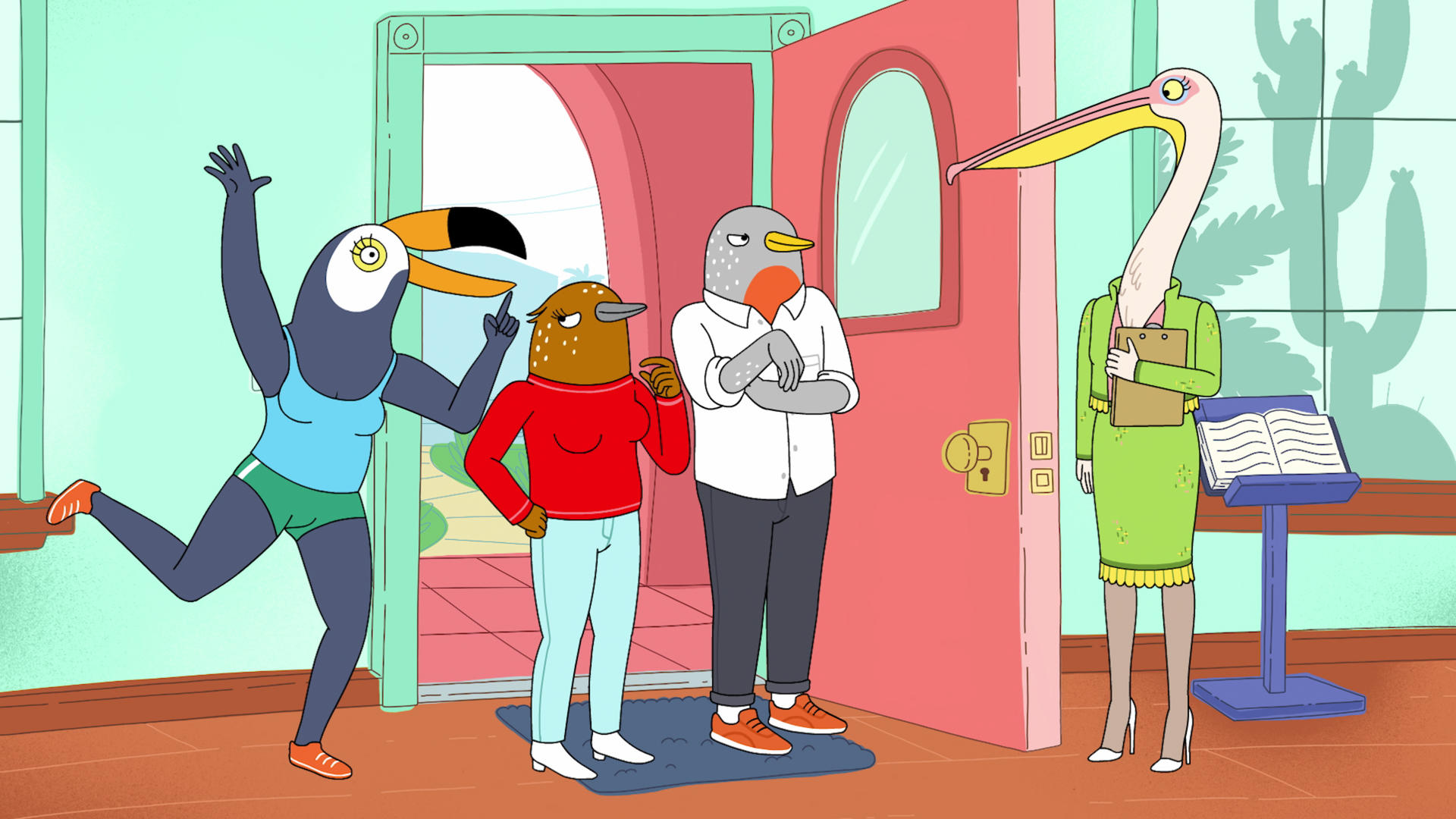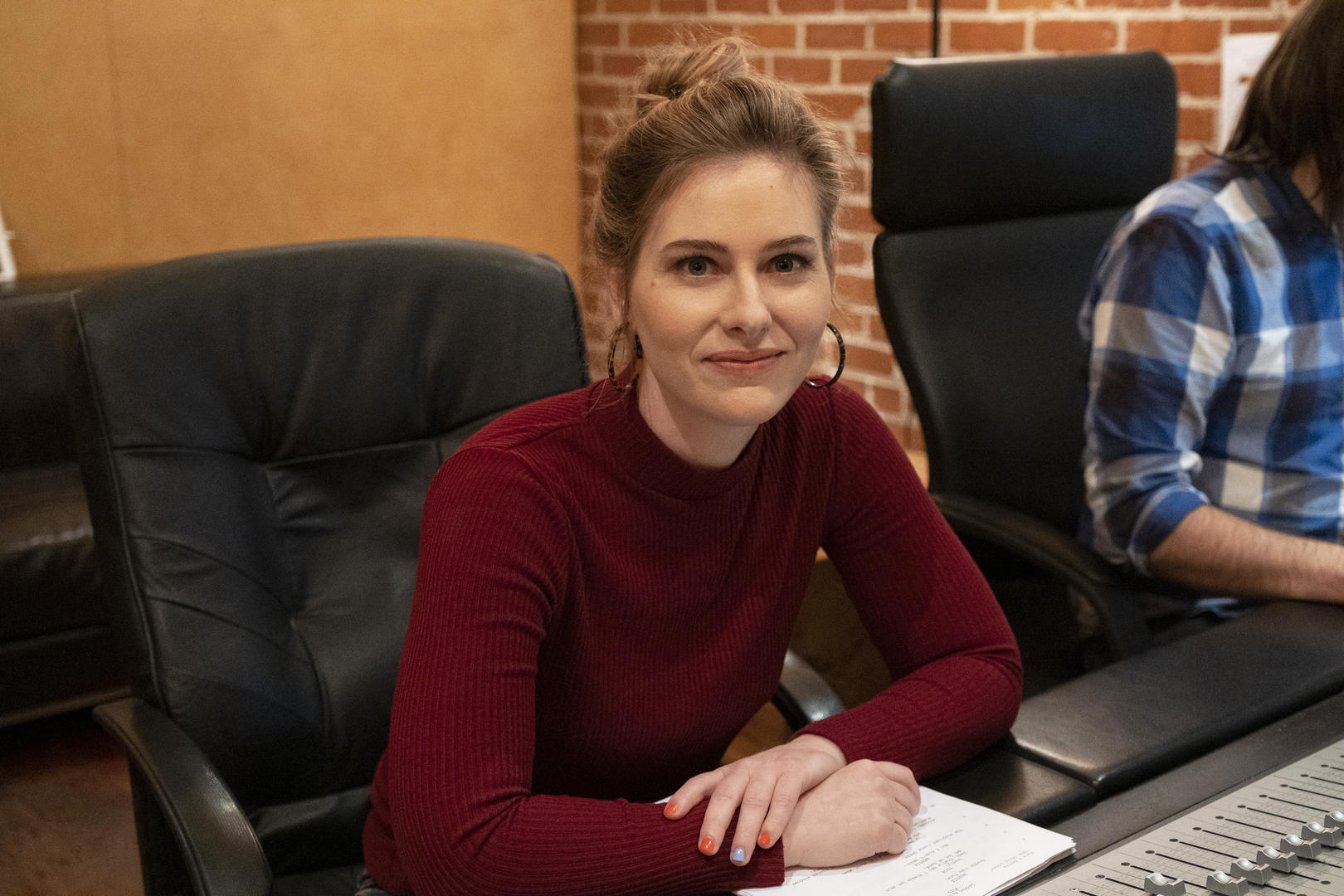
Fans of BoJack Horseman, who love their cartoons whimsical, full of puns and served with a side of depression, have cartoonist-designer-producer Lisa Hanawalt to thank. And in a happy turn of events for those viewers, Hanawalt has created a new show, this one delving into the lives of two thirty-something anthropomorphic birds. Tuca & Bertie, which premiered on Netflix earlier in May, follows a toucan and a song thrush, a pair of best friends living in the colorful, almost psychedelic setting of Bird Town, who help each other through the tribulations of adulthood that are too scary to handle alone.
The outgoing and enthusiastic Tuca (voiced by Tiffany Haddish) is the wilder of the two, while Bertie (voiced by Ali Wong) is slightly more timid and prone to anxiety spirals. In the show, Hanawalt takes a familiar sitcom premise and upends it by blending the animals’ characteristics with human personality traits, lending all her creatures their unique qualities. On Tuca & Bertie, the typical coworker who always steals your ideas in a meeting is, of course, a rooster. Plants, whose leaves and stalks have never looked so aloof and intimidating, are the teenagers on the street who will always be cooler than you.
But along with the vibrant shapes and colors that make up Bird Town is a healthy dose of the realities of making it in the, well, real world. Tuca and Bertie, together and separately, face many of the challenges that can come with no longer being in your twenties, like the difficulty of making friends as an adult. Below, Hanawalt talks to TIME about the inspirations behind Tuca & Bertie.

TIME: Why were birds the right choice for the characters here?
Hanawalt: I just like looking at birds and thinking about them. I had made up these characters for my comics and had comics about Tuca from years ago. I saw a toucan in a nature documentary and related to how greedy it was when it was stealing eggs out of other birds’ nests and eating — the perfect animal to represent my id. I tend to like animals with long noses, anyway. And I made these other comics about Bertie and her boyfriend, Speckle, and she was more of a shy, small, anxious character, so a song thrush seemed like a fun way to represent her. Birds are very cute but also kind of creepy, and they also wear all their emotions on their sleeve. They’re kind of like toddlers.
The way Bertie navigates the world, worried all the time, really jumped out in its realistic portrayal of anxiety. What kinds of experiences and emotions did you draw on when writing her storylines?
It was something I hadn’t quite seen in an adult comedy, the feeling of moving through the world as an anxious person, not only because of things that are externally happening to you but because you were born that way. I run a little anxious. I have to come up with ways to cope with that. That “I’m Losing My Sh-t” song about how she’s losing her sh-t for no reason — that was a song I sang while pitching the show. The part where Speckle uses a worry vacuum [to suck all of Bertie’s worries away] was based on something my own boyfriend, Adam Conover, has done. He actually did shatter a glass with a fake worry vacuum.
It was hard to explain when first pitching the show. Executives would ask, “Why is she anxious? What caused it?” And I’d be like, “I don’t know. She just is anxious.”
How do the species of your characters help you shape their personalities? Do you look at a plant and get the sense that it’s a teen that’s judging you?
It depends on how I think of the animal. It’s something I wasn’t allowed to do on BoJack, make plant people, and when thinking of unique characters, it was fun for plants to be a little mysterious. When designing Draca, the plant lady neighbor, I was almost thinking of her like Rihanna or someone. Like, she’s so cool, she can wear things that none of us can get away with and I would just die if she even talked to me. It’s funny to represent that with plant.
But individual animals, to me, have very specific personalities. Cats I’ve had are different from other animals I’ve had of the same type. I like thinking about them as individuals. Qualities of animals do help with certain characters. Derek, on Tuca & Bertie, is a cock. He’s a rooster. There are obvious reason for that. In the Tuca & Bertie universe, geese are sort of idiots. It’s a stereotype they’ve come up with and it’s probably unfair of them, but that’s the case in this world. I think I probably am not the biggest fan of geese in the real world either, but I respect them.
Can you talk more about the choice to make Tuca actively sober? She’s typically the more upbeat and positive one of the two, but that decision takes a level of introspection and vulnerability.
In my life, I know a lot of Tucas who have become sober in their thirties. That’s one thing that sets this decade apart from the twenties, when I think people tend to go kind of wild a little more. You reach your thirties and are like, “Oh, I have to get my sh-t together.” That’s when a lot of people make these decisions for themselves.
I wanted to write a character where it’s not that dramatic. We don’t see her hit rock bottom. We don’t see her relapse. That’s not really the conflict there. It’s more just her adjusting to her life after making this change — it’s hard for her to go on dates, it’s hard for her to form intimacy with other people, except for Bertie. I’ve had friends who have had those same struggles. To me, it just felt realistic, and it kind of helped ground and strengthen her character. Like, maybe she’s outgoing and wild because she has social anxiety, or this is the way to deal with it? I didn’t want her to just be the “wacky friend.” Because she does have Bertie qualities. And meanwhile, Bertie can do something crazy and spontaneous, and she has Tuca qualities to her. It shows why they can remain friends for so long.
Tuca & Bertie has a very specifically female point of view, particularly for an animated show, which are typically not about women. How were you purposeful about the show’s perspective?
Animated shows are largely made and written by men. I wanted to write about things that interest me. Even on BoJack, where the staff is half female most of the time, there’s times I want to linger more on a story about Princess Carolyn or Diane [two of the show’s lead female characters]. So when I’m in charge of my own show, I’m like, yeah, this is going to be the central plotline. We’re going to see what it’s like for this character to live in the world. We’re going to see what it’s like when a plumber comes to fix the sink and she doesn’t know whether to trust him or not. I wanted to explore stories about unreliable mentors and what that’s like when you’re working, childhood trauma — all this stuff I dealt with in my own life. People sort of loop it into the #MeToo movement but it wasn’t my intention to address that directly. For me, it’s not a trend or a hashtag. It’s my life.
More Must-Reads From TIME
- The 100 Most Influential People of 2024
- Coco Gauff Is Playing for Herself Now
- Scenes From Pro-Palestinian Encampments Across U.S. Universities
- 6 Compliments That Land Every Time
- If You're Dating Right Now , You're Brave: Column
- The AI That Could Heal a Divided Internet
- Fallout Is a Brilliant Model for the Future of Video Game Adaptations
- Want Weekly Recs on What to Watch, Read, and More? Sign Up for Worth Your Time
Write to Mahita Gajanan at mahita.gajanan@time.com